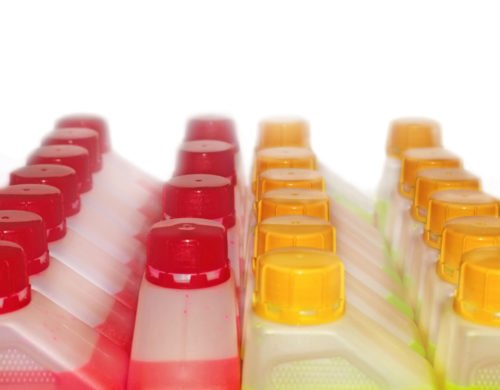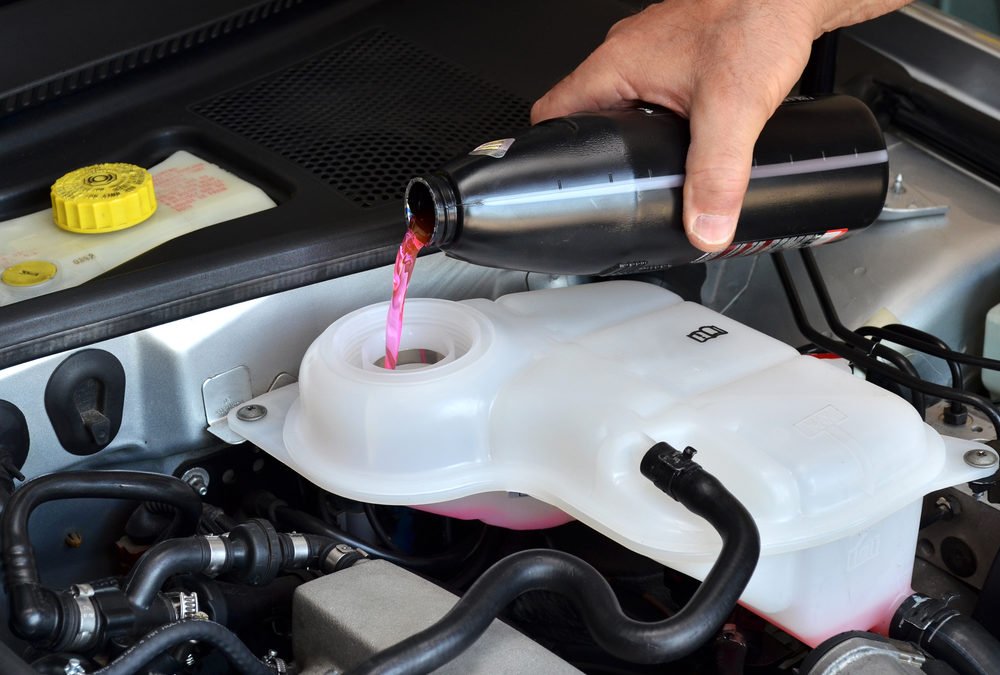
Topping up the coolant in the cooling system reservoir
What is coolant?
Coolant ( either ethylene glycol or propylene glycol) is diluted (usually 50/50 with distilled water) antifreeze. It is used for several purposes in your vehicle. As the antifreeze name would describe, in winter it stops the water from freezing. In the summertime, it also helps to dissipate some of the heat from your engine to avoid overheating. Coolant also helps keep your vehicles cooling system clean with rust inhibitors. Rust, dirt and other particles can clog up the cooling system and cause problems.
What colors does coolant come in?
Variations of coolant/antifreeze can come in; pink, red, orange, blue, green, and yellow. This can make it confusing when trying to decide which coolant you need in your vehicle. The different colors can mean different properties of the liquid.

Coolant colors yellow and red
3 main types of coolant
- Inorganic Acid Technology (IAG)-Typically used in older cars up until the mid-90s in the U.S, contains phosphates (corrosion inhibitors) and silicates. Lasts around 2 years. Usually bright green.
- Organic Acid Technology (OAG)- Found in most newer cars, does not contain silicates or phosphates but has azoles and neutralized organic acids (corrosion inhibitors). Provides high-temperature protection for aluminum. Lasts about 5 years. Typically, orange or red in color.
- Hybrid Organic Acid Technology (HOAT)- A mix of the above two types of coolant. This has silicates and has an extended life lasting up to 5 years. Typically orange or yellow.
Which color coolant to use?
As a quick guide, if your topping up the coolant levels, use the same color as is in the vehicle already. However just because it’s the same color doesn’t necessarily mean it’s the same type. Check in your owners manual to see exactly which type of coolant to add to your vehicle. You can also check with your (manufacturer) dealership parts department. Various aftermarket companies and vehicle manufacturers use different colors. For example, Toyota has green and red, but it depends on the year and model of the vehicle as to which kind is needed.
Never mix different types of coolant
Unless you’re an expert on the exact chemical composition and reactions of the various types, keep it simple and stick with what the manufacturer recommends. Mixing the wrong types could cause radiator and cooling system damage (which could lead to engine/waterpump damage) and a repair bill that’ll make you pass out on the floor. Which could then lead to an expensive doctors bill. Check the owners manual.
How much dilution?
First, check to make sure the solution of coolant/antifreeze you buy is not already pre-diluted. From concentrate, most of the time a 50 percent coolant and 50 percent distilled or de-ionized water dilution is recommended.This will protect the system from freezing to about -34 F. For temperatures below that, up to 70% coolant concentrate can be used. Tap water or well water is not recommended due to the minerals in the water.
How often should you change it?
This again depends on your specific vehicle’s manufacturer recommendation. Check the owners manual for your vehicle of with your service dept. Some vehicles require it every 2 years whilst others can come with a ‘lifetime’ blend of coolant. It’s worth noting though, that even though the liquid may still show as ‘full’ in your tank, the active properties of the chemical composition may not be working anymore (ie. it might not be working as intended). A tool called a ‘coolant hydrometer’ can be used to check the specific gravity of the coolant. It won’t tell you if the coolant is still protective against corrosion though.


Recent Comments